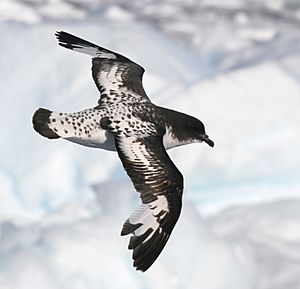Procellariidae facts for kids
Quick facts for kids Procellariidae |
|
|---|---|
 |
|
| Cape petrel (Daption capense) | |
| Scientific classification | |
| Genera | |
|
Macronectes |
|
| Diversity | |
| 16 genera and about 70 species |
The Procellariidae are a large family of amazing seabirds. They include birds like fulmarine petrels, gadfly petrels, prions, and shearwaters. These birds are part of a bigger group called Procellariiformes, often known as "tubenoses." This name comes from their unique tube-like nostrils on top of their bills. Other birds in this group are albatrosses, storm petrels, and diving petrels.
Procellariids are the most common and varied family of tubenoses. They come in many sizes. Some, like the giant petrels, are almost as big as albatrosses. Others, like the prions, are as small as the larger storm petrels.
Contents
What Procellariids Eat
These birds are excellent at finding food far out at sea. They mostly eat fish, squid, and small crustacea (like tiny shrimp). Many also eat food scraps from fishing boats or dead animals floating in the water.
Their Amazing Journeys
Many procellariids travel very long distances. Some even fly across the equator during their migrations. This means they travel from one side of the world to the other!
Their Homes and Families
Procellariids are "colonial breeders." This means they gather in large groups to lay their eggs and raise their chicks. They often return to the same nesting spots year after year. They also tend to stay with the same partner for a long time.
Each pair of procellariids lays only one egg per breeding season. Their eggs take a very long time to hatch. Also, their chicks need a lot of time to grow before they can fly on their own. This period is much longer compared to most other birds.
Procellariid Populations
Some types of procellariids have huge populations, with millions of breeding pairs. But sadly, other types have very few birds left, sometimes fewer than 200.
People have traditionally used some species, like fulmars and shearwaters (sometimes called "muttonbirds"). They were used for food, fuel, and bait. This practice still happens today, but it is carefully managed.
Challenges They Face
Many procellariid species are in danger. One big threat comes from introduced species. These are animals, like rats or cats, that humans bring to the islands where the birds nest. These new animals can attack adult birds and their chicks.
Another danger comes from long-line fishing. This type of fishing uses very long lines with many hooks. Procellariids can get caught on these hooks while trying to find food.
Images for kids
-
To take off this Christmas shearwater (Puffinus nativitatis) must face into a strong wind. In calm conditions it must run in order to obtain a high airspeed.
-
The broad-billed prion (Pachyptila vittata) filters zooplankton from the water with its wide bill.
-
The colonies of the great shearwater (Ardenna gravis) are among the densest of any procellariid, with 1 pair per m2.
-
Christmas shearwaters (Puffinus nativitatis) are one of the surface-breeding procellariids. Here a pair engages in some mutual preening.
-
A northern fulmar (Fulmarus glacialis) pair perform a cackling duet.
-
The chick of a Bonin petrel (Pterodroma hypoleuca) takes almost three months to fledge. This chick has most of its adult plumage but still retains a considerable amount of down.
-
Sooty shearwaters (Ardenna grisea) are still harvested in New Zealand using traditional techniques
-
Northern fulmars (Fulmarus glacialis) flocking at a long-lining vessel in the north Pacific
See also
 In Spanish: Proceláridos para niños
In Spanish: Proceláridos para niños











